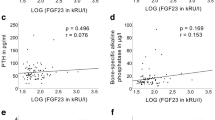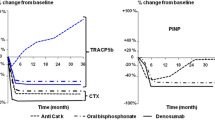Abstract:
Osteoporosis is a major public health problem characterized by low bone mineral density (BMD) that presently has no biochemical test useful for its diagnosis. The cytokine TGF-β has been postulated to play a role in controlling bone density by regulating the fine balance between bone matrix deposition by osteoblasts and its resorption by osteoclasts. We explored whether measurement of serum levels of different TGF-β isoforms could be useful as a clinical tool in osteoporosis. We measured the concentration of TGF-β1 antigen using the BDA19 capture sandwich enzyme-linked immunosorbent assay (ELISA), TGF-β2 antigen concentration using a Quantikine sandwich ELISA kit and TGF-β3 antigen concentration using a modified version of the TGF-β1 Quantikine sandwich ELISA kit. Subjects were 41 women with osteoporosis (with nontraumatic vertebral fracture or lumbar spine BMD Z-score <−1.5 SD) and a total of 199 control women from different sources. Serum concentrations of TGF-β1 and TGF-β2 were similar in all groups. However, detectable levels of TGF-β3 (>0.2 ng/ml) were found in 35 of 41 patients with osteoporosis (median 7.2 (5.2–8.9) ng/ml) compared with 11 of 36 controls or 24 of 89 healthy women of unknown bone density. Differences among the groups could not be accounted for by age, weight, medications, use of hormone replacement therapy or the presence of osteoarthritis. Using the optimal cut-off of ≥2 ng/ml, the test was able to detect an individual with low spine BMD (Z-score <−1.5) with a sensitivity of 84% and a specificity of 53%, with similar results for the femoral neck. The odds ratio for osteoporosis associated with a positive test at this level was 5.93 (95% CI 2.41–11.59), and 4.1 (95% CI 1.66–10.11) using the WHO cut-off of T-score <−2.5. Serum TGF-β3 concentration is raised in osteoporotic women and the test appears to have potential as a marker for osteoporosis. The underlying mechanisms and the relationships between TGF-β3 and bone turnover and fractures remain to be explored.
Similar content being viewed by others
Author information
Authors and Affiliations
Additional information
Received: 4 April 1998 / Accepted: 21 September 1998
Rights and permissions
About this article
Cite this article
Grainger, D., Percival, J., Chiano, M. et al. The Role of Serum TGF-β Isoforms as Potential Markers of Osteoporosis . Osteoporos Int 9, 398–404 (1999). https://doi.org/10.1007/s001980050163
Issue Date:
DOI: https://doi.org/10.1007/s001980050163




